A wild Aussie paradise so little-known, one man came here to escape the Kremlin
By Sue Williams
Yearning to get away from it all to a place where life is simple and straightforward, pretty much unchanged by time and outside influences?
The solution may be much closer than you think: the wild lands of Australia’s final frontier, the remote Dampier Peninsula in the country’s far north-west, 200 kilometres north of Broome.
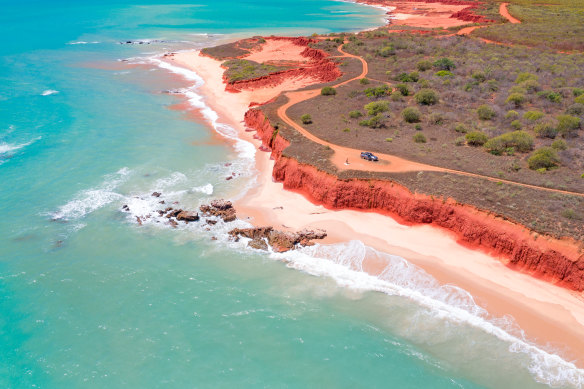
The red-ochre cliffs at James Price Point.
This is a totally unspoiled universe of ochre-red cliffs, pristine white-sand beaches, clear turquoise waters, starry starry nights and welcoming Indigenous communities. It’s also home to all manner of wildlife, from giant barramundi to monster mud crabs, from great basks of crocodiles to a breathtaking variety of birds, including the rare Gouldian finch, as well as 130-million-year-old dinosaur tracks.
“It really is an incredible place and most Australians don’t seem to know it at all,” says Brit Nick Stride* who, with his family, fled here and hid out for over three years – undiscovered – after he was targeted by the Kremlin after leaking Russian secrets.
“For us, it was a question of survival but for anyone going there properly equipped for a holiday, it would be simply amazing. We saw so many astonishing sights, had so many extraordinary experiences and learnt so much from the local communities, it really changed our lives. I can’t wait to go back one day, and I wouldn’t hesitate to recommend it to others.”
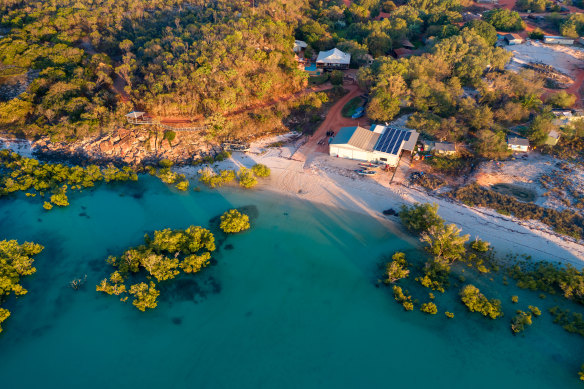
Dampier Peninsula is 200km north of Broome.
Stride, who now lives in New Zealand, describes his family’s life on the peninsula in a new book, Run For Your Life, including their exploration of historic sites, fishing, crabbing, boating, working with First Nations communities and helping with local projects to trap dangerous crocodiles. With the book now also out in the UK and US, it’s likely this isolated stretch of outback Australia could now be the focus of a great deal more attention from overseas visitors, too.
Yet for those not escaping in fear for their lives, travel around the Dampier Peninsula, accessed these days via the sealed all-weather road from Broome to Cape Leveque, past those dinosaur tracks, is likely to be a great deal more relaxed, with a complete other-worldly feel and plenty of fascinating locations to visit along the drive north.
This can be done as a self-drive road trip, preferably in a 4WD, as part of a tag-along tour, on an organised 4WD tour or with a helicopter flight from Broome, with many cultural experiences available along the way.
One of the best attractions is Willie Creek Farm, a modern pearling operation close to the start of the road north. There are regular tours operated by the farm, and it’s hard to believe the electric blue of the water as you glide on a boat to view the live oysters suspended among the native flora.
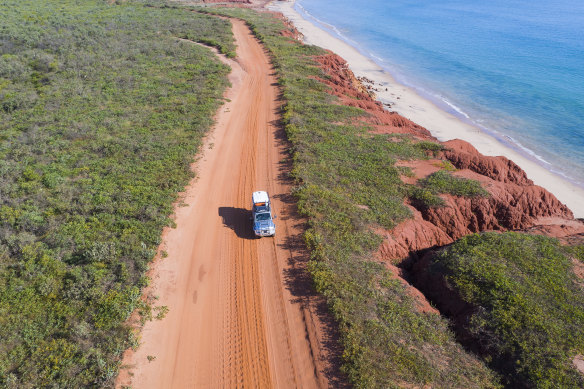
Travel around Dampier is best done in a 4WD.
There’s also an oyster “nursery” to visit, and to gain lessons on how oysters are seeded and harvested, topped off with a selection of beautiful pearl jewellery to salivate over. You can stay here too, on a roomy three-level houseboat.
Further north, along the red, red road, fringed with timeless bush and beach, there’s Beagle Bay, a settlement of the Nyul Nyul people, with its beautiful Sacred Heart Church, known for its stunning shell altar of mother of pearl, cowrie, volute and olive snail shells. It was built by hand by local Aboriginal people and Pallottine monks who’d operated a mission in the area in the late 1800s.
This fabulous building, now heritage listed, has a three-storey square belltower that takes your breath away – especially as it’s so off-the-beaten track, and totally unexpected, near the Beagle Bay Creek with its tidal black soil, mangroves, vivid wildflowers, plentiful fish and crocodiles. That’s another favourite place to fish for giant barra, to bush bash or just to enjoy nature, with egrets, brolgas and bee-eaters, wallaroos, dingos, wild donkeys and frilled-neck lizards.
The National Heritage-listed coastal wilderness of Pender Bay, 25 kilometres further north along a 4WD-only track, is another stunning sight. There are millions of tiny blood-red crab shells scattered on the white sands fringing the turquoise ocean which, in the bright sunlight, glitter scarlet. Together with the striking rust cliffs that line the shore, the whole area has a rosy glow.
The deserted beach is a haven for birdlife, fish, molluscs and humpback whales in season, when they begin their annual migration north from Antarctica. There are unpowered sites for camping, as well as safari tents and cabins.
Not far away, is the tiny town of Lombadina on Thomas Bay, with a bush timber church, shell middens, footprints of Indigenous ancestors hundreds of years old and a craft shop, stacked with traditional arts all based on their saltwater heritage.
Here, there is also a variety of tours by First Nations locals. A kayak tour, paddling through the crystal-clear water, and a snorkel, a fishing charter, a whale-watching cruise, or a mud crabbing tour, followed by a delicious feast of mud crab, are perfect ways to experience the vibe, while there’s a lodge to stay in, cabins, single rooms and powered and unpowered campsites.
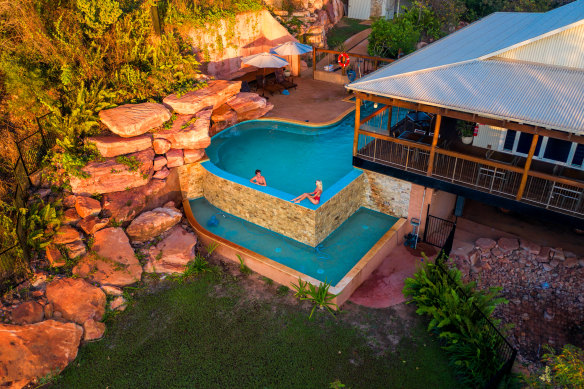
Cygnet Bay Pearl Farm is on the tip of the Dampier Peninsula.
But probably the best-known draw of the whole area is another pearl farm, this time on the tip of the Dampier Peninsula, the iconic Cygnet Bay Pearl Farm. Owned by four generations of the same family since founded in 1946 by one of Australia’s true pearling pioneers, Dean Brown, it first opened its doors to visitors in 2009.
Now, it’s a fascinating spot to explore with mangroves, tidal creeks, small sandy beaches, the horizontal waterfalls, the Buccaneer Archipelago, sea safaris and bush tracks, and a fabulous range of accommodation, with new eco safari tents in its Pearler’s Village just winning a gold award in the “unique accommodation” category of the latest Qantas Australian Tourism Awards.
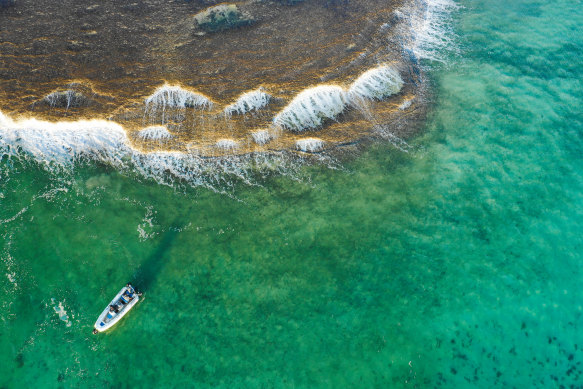
A tour from Cygnet Bay Pearl Farm takes in Waterfall Reef.
There’s also glamping on the secluded creeks and old pearling shacks and camping and caravan sites. An infinity pool is perfect to cool off in, while there’s also a licensed restaurant, with meals made from local and native ingredients. Fourth-generation pearler and proud Bardi man Terry Hunter gives guided tours of his home and country, exploring the tidal flats and foraging for oysters.
Finally, even further north at the tip of the peninsula, is Ardyaloon, or One Arm Point, a 400-strong Aboriginal community with an intriguing history. It had originally been established on Sunday Island off the coast in 1899 – this lasted until 1960 when the Uniting Church Mission, which had taken it over, was closed.
Everyone was relocated to either Broome or Derby but, as saltwater people who traditionally fished and hunted, the locals couldn’t adapt to town life and moved to Ardyaloon instead. Now, it has an amazing aquaculture centre and a lookout from where you can watch one of the biggest tides in the world wrap itself around the islands off the coast.
First Nations culture has remained fabulously strong on the peninsula with several Indigenous tours for visitors. There are boat tours over to Sunday Island with Jawi woman Rosanna Angus, whose family lived there during the early mission days, and cultural tours by Bardi traditional owner Bundy, still living as previous generations did, and walks with Bardi-Jawi man Bolo Angus through his ancestral lands of mangroves, paperbark forests, salt plains and creeks, talking about hunting techniques, bush tucker, bush medicines and how to find fresh water.
Getting away from it all? You could hardly go any further.
THE DETAILS
FLY
Qantas, Virgin Australia and Jetstar all fly regularly to Broome from various capital cities.
STAY
There’s a huge range of accommodation available, from bush camping sites to lodges, powered sites to luxury eco-safari-style glamping tents and houseboats. Make sure to book in advance, especially during peak dry season from May to October. See australiasnorthwest.com
The writer travelled at her own expense. Run For Your Life, a book by Sue Williams about the Stride family, including their time on the peninsula, is out from Simon & Schuster. RRP $34.99
Sign up for the Traveller Deals newsletter
Get exclusive travel deals delivered straight to your inbox. Sign up now.